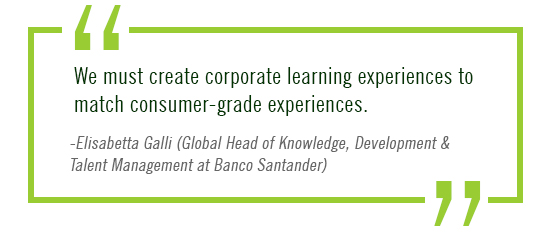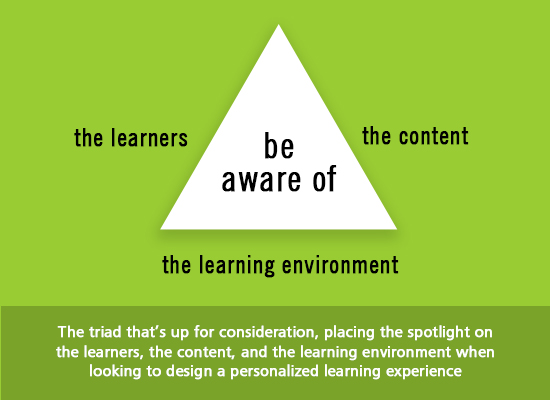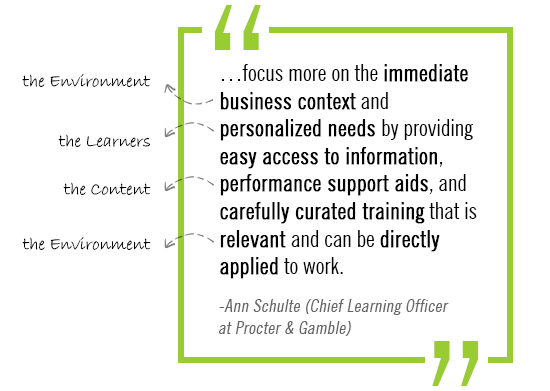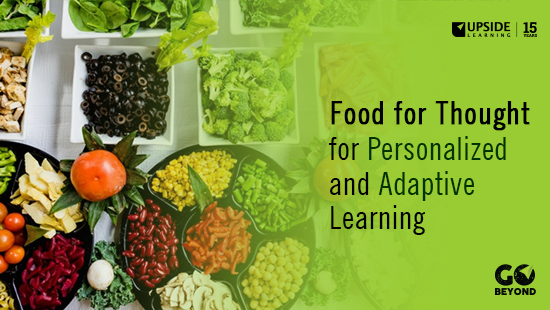Living in a world where everything’s personal
When thinking about how learning designers can practice designing personalized learning experiences, here are some of the words that come to mind:

So what is it really that has triggered personalized and adaptive learning as the hot topic in recent trends? In an age where the Marketing industry has mastered the art of personalized communication, the L&D industry can be seen joining the bandwagon, inching its way towards creating integrated experiences for content consumption (let’s also think beyond just the consumption of ‘learning’, I’ll be sharing my thoughts on this in a separate post).
Whether it’s online shopping, language-learning through an app, or a humble habit tracking app—everything’s personalized for us. I say ‘us’ because the ‘learners’ we as L&D cater to are us, people like you and me, real people with real challenges with performance- and knowledge-based skills.
Some industry experts are now making a deliberate effort NOT to label them ‘learners’ since the word seems to somehow dehumanize them and lends a limiting perspective to seeing the workplace as an ecosystem, as the driver of learning experiences. For all intents and purposes, I will continue to use the word learner, for now, as long as we’re clear that it refers to the ‘consumer’ equivalent from Marketing—representing a human at the other end of our learning design efforts.
So I feel a lot of the effort towards personalizing content consumption experiences draws from consumer experiences that personalized marketing targets. In this context, a quote by Elisabetta Galli (Global Head of Knowledge, Development & Talent Management at Banco Santander) really hit home. She says, “We must create corporate learning experiences to match consumer-grade experiences.” And this is in line with something Gemma Critchley (Head of Technology & Innovation for Learning at Aviva) said on a recent podcast—make learning more like real life.

What industry leaders feel about personalized learning
Before taking a sneak peek into how organizations can make the most of personalized and adaptive as a learning design strategy, I thought it might help get a sense of what the vibe is across the industry considering this hot topic.
An HBR article shares what business leaders, L&D leaders, and executives from the C-Suite have to say about the way learning initiatives should be approached in general. Sifting through industry-wide views on the context of learning, the words ‘personalized’ and ‘adaptive’ resonate strongly, and pushed me to see the pattern—a triad of key players in any corporate learning setup.
- Designing for Learners: Real People with Real Problems
Gemma Critchley highlights the need to create experiences that feel like ‘real life’ and not ones that are isolated and disjointed from the flow of work, and feel like a ‘field trip’. - Designing the Content: The Messaging to Help Solve Business Problems
Ann Schulte, Chief Learning Officer at Procter & Gamble (P&G), emphasizes the significance of ‘carefuly curated’ training that is easy to access. - Designing for the Context: The Environment
Helen Smyth, Group Digital Learning and Design Manager at Sainsbury’s, encourages that we focus on the context of the learning material, that is, the practicability and application of the content.
Why personalization? Because we design for humans
Andy Lancaster (Head of Learning at CIPD) who authored ‘Driving Performance through Learning,’ relays the fast-changing, dynamic nature of businesses themselves and organizations as some of the key themes centred on business transformation initiatives. These draw up three aspects: the way work is done (operations); the workforce (the drivers of the business—the people); and the workplace itself (the physical location). In the midst of this flux, personalized and adaptive learning promises a multi-dimensional approach to learning initiatives.
Some of the obvious and much talked about benefits of personalized and adaptive learning are:
- The ability to cater to a multi-generational workforce (with millennials comprising about 75% of the global workforce)
- The opportunity to help employees discover their own journeys (learner autonomy)
- The chance to efficiently deliver tailored content based on learner proficiency, experience, capability, among others
- The nudge to open up the conversation to collaborative learning
In a world where the general public as consumers gets to pick and choose what they like and swipe through media-rich experiences, learning initiatives should also sing to the same tunes, and here is where personalization can help as the go-to, rather than an ‘add-on’ feature, towards crafting personalized journeys and learner paths.
The essence of personalized learning? A triad to the rescue
Keeping these terms on the radar, I got to thinking about the common denominators for any effective learning experience. The unspoken recommendation from industry leaders seems to re-center the needle towards three key elements that promise a personalized experience:

I’ve jotted down my thoughts on this triad as a generic thinking tool for learning design in a LinkedIn post, so in this article I’d like to focus my thoughts on this triad towards personalization.
The Learners
It’s all about designing experiences for real people who face real challenges in their work. This means understanding that they come with their set of experiences, thoughts, and apprehensions; and have unique levels of proficiency, skill sets, and domain expertise—and are not just one generic set of people we represent with the word ‘learners.’
Examples of Personalization: Role-centric learning design, learning interventions that offer levels of expertise to consume content
The Content
Knowing who you’re designing for means knowing the level of granularity of content that you’d like to include—is there a repository to tap in on, and how can the content be accessed easily? It also boils down to what form of messaging and communication best appeals to learners, and helps them address their challenges—this ultimately helps the business progress.
Examples of Personalization: The same content positioned differently for different audiences
The Environment
The design approach also needs to consider the learning environment, the environment in which learners will consume the content, and the context in which they will be applying the knowledge acquired or experienced, that is, when thinking of how to contextualize the learning design.
Examples of Personalization: The chance to locate and access resources at the point of need
In line with these thoughts, Ann Schulte’s quote captures the multiple aspects of personalized learning:
“To help our people learn faster, we are disrupting how we manage learning and development to focus more on the immediate business context and personalized needs by providing easy access to information, performance support aids, and carefully curated training that is relevant and can be directly applied to work.”
If this could be considered an all-encompassing definition of sorts of personalized learning design, the triad captures the essence. And the trick is to capture the right insights for each aspect of the triad.
Enter Learning Analytics (that’s right, the can of worms that anyone who sees the similarities between L&D and Marketing can’t help be intrigued by).
The common thought across the spectrum of L&D practitioners is that the industry is finally warming up to this aspect of Marketing, slowly but surely, so 2020 looks onwards and upwards for the prospect of using learning data and analytics not as ‘autopsy’ (like Gemma Critchley rightly says), but as a diagnostic measure to plan learning experiences and define learning design strategies that suit workplaces of the future.

Some immediate thoughts
When thinking of workplaces of the future, the surge in tech-enabled and tech-supported learning experiences is inevitable. And in the context of tech-enabled personalized learning, there’s Artificial Intelligence (AI) and AI-powered learning platforms, and Machine Learning to help design and develop ‘smart learning environments’.
Whether it’s simply creating learning paths to cater to multiple learner groups, or design an adaptive learning environment that pushes only the relevant content out automatically—these approaches all make for great personalized experiences. So as learning practitioners, it would certainly help think about how we can make the most of learning tech and design tailored experiences that hit the mark. More on this in Part 2!



















